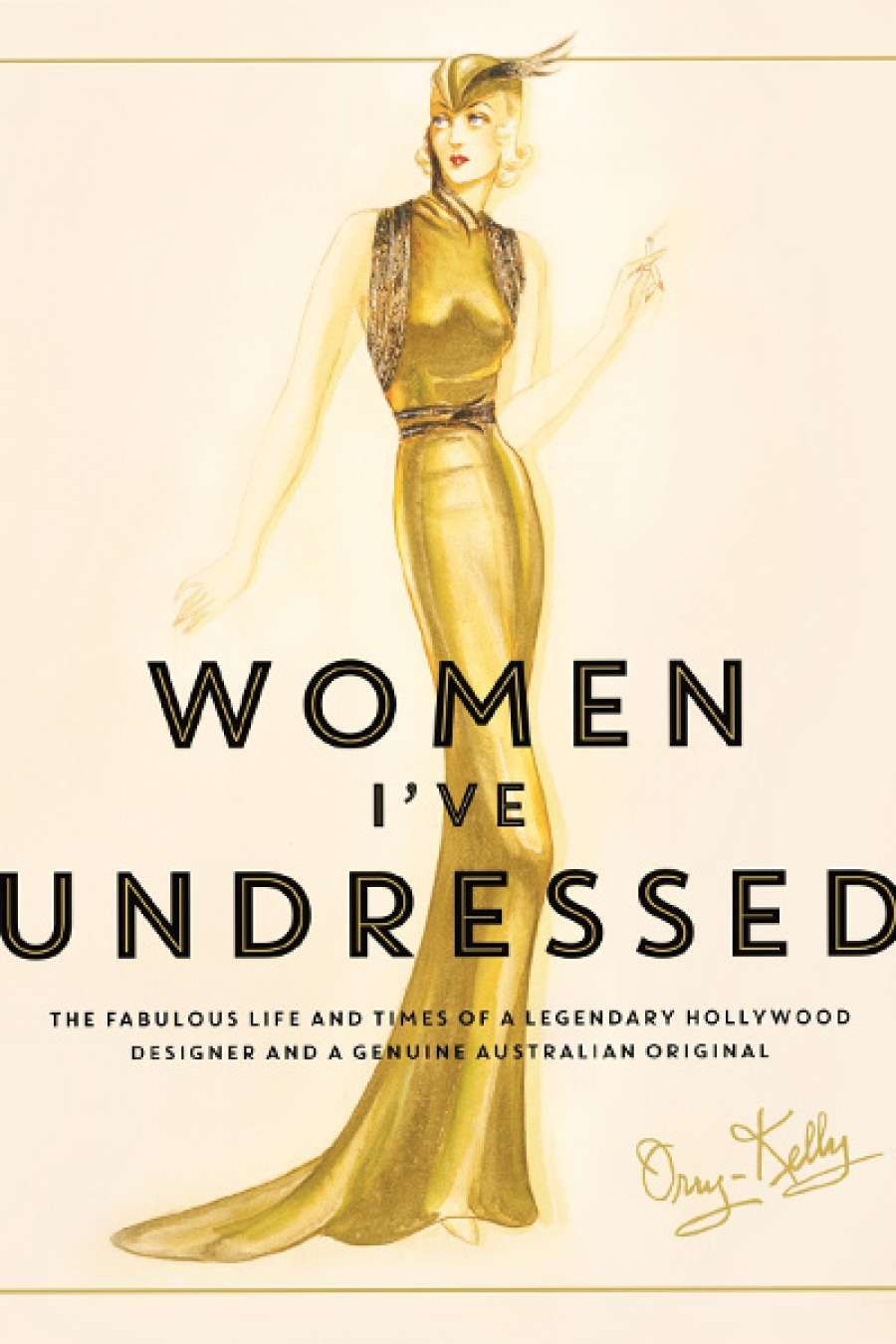
- Free Article: No
- Contents Category: Film
- Custom Article Title: Desley Deacon reviews 'Women I've Undressed' by Orry-Kelly
- Review Article: Yes
- Online Only: No
- Book 1 Title: Women I've Undressed
- Book 1 Subtitle: A Memoir
- Book 1 Biblio: Ebury Illustrated, $39.99 hb, 432 pp, 9780857985637
Random House has published this 400-page memoir in a lavish edition with a foreword by Catherine Martin, herself a four-time winner of the Oscar for costume design, and with an afterword by Gillian Armstrong. It is printed on heavy multi-coloured matte paper (in shades of pink and mauve), has many stunning illustrations, including Kelly's own paintings, a glossary (Kelly speaks an outdated slang), and a filmography. Although beautiful, the book is a squat octavo that does not work as a coffee table book and is far too heavy to read in bed.
But is Women I've Undressed worth all this trouble, and is anyone going to want to read it in bed? Orry-Kelly's story is undoubtedly fascinating. Brought up in the New South Wales seaside town of Kiama, the son of the local tailor and his second, artistically inclined wife, the young Orry (yes, it was his real name, of Manx origin) flourished in elocution and art classes. He left for the 'big smoke' as soon as he could, and survived on the fringes of Sydney's theatrical world until, at age twenty-five, in 1923, he set off for New York. There he roomed next to Gracie Allen, later partner and wife of George Burns, and became the best friend (lover?) of a member of a stilt-walking group named Archie Leach. He and Leach, as Kelly-Leach, manufactured and sold hand-painted ties designed by Kelly. Both moved up through the theatrical fringe until they landed, separately, in Hollywood in 1931, where Archie became Cary Grant and Kelly became Orry-Kelly, costume designer at Warner Bros.
Orry-Kelly was brilliant and innovative. In the 300-odd movies he dressed between 1932 and 1963, he provided elegant clothes for leading stars from the sophisticated Kay Francis in the early 1930s to the sexy Marilyn Monroe of the late 1950s. Bette Davis, on her way to stardom in the mid-1930s, prized him for his forthright personality and for his skill at disguising her physical faults. After the Academy Award for Best Costume Design was inaugurated in 1948, Orry-Kelly won the Oscar three times, for An American in Paris (1951), Les Girls (1954), and Some Like It Hot (1959). He died of cancer in 1964.
 Orry-Kelly with Kay-Francis (photo courtesy of Scotty Bowers)
Orry-Kelly with Kay-Francis (photo courtesy of Scotty Bowers)
'One of the most interesting stories surrounding the making of Women He's Undressed was the finding of this long-lost manuscript'
Kelly wrote Women I've Undressed at the end of the 1950s, when he was in his early sixties and off the bottle that had often endangered his career. An 'out' homosexual among his friends, he was ten years too early for the revolution that would have allowed him to speak openly about his life and loves. The memoir therefore appears insufferably old-fashioned in its coyness about his sexuality and its sheaf of alcohol-soaked stories.
Kelly was a great 'hemstitcher' but a poor writer, with little sense of proportion. In the full flush of enthusiasm in the book's early pages, he tells interminable stories of his youthful experiences among the prostitutes, sly grog shops, and pickpockets of Sydney, and continues this fascination with madams and speakeasies in the section on New York.
Anyone who buys this book wants to know about his 'hemstitching' – how was this organised in the movie studios? How did he go about the process of designing and making the clothes? What did he do to make the most of the different stars? This is the most disappointing part of the memoir. Half the book is taken up with 'getting there'; the rest is fairly random Hollywood gossip. My hopes were raised when Kelly began talking about 'shirtmakers', 'tailored arrowheads', and 'inverted pleats' with regard to Kay Francis's wardrobe. But after that it is pretty much whether Ruth Chatterton was getting divorced, Olivia de Havilland was 'kind', Elsa Maxwell's behind in pants was 'nauseating', and so-and-so was a 'bitch'. I must admit I had almost stopped reading before Marilyn Monroe arrived (at page 400, dear reader – there is no index). Suffice it to say that she had a bad temper, a foul mouth, and a plump rear end.
For those who are interested, the book sheds no light on the Orry Kelly–Cary Grant relationship. In true pre-Stonewall style, Kelly emphasises Grant's proclivity for 'blondes'.
It is one of the paradoxes of publishing that this lavish and vacuous book sells for $39.99 when more worthy histories retail for more than one hundred dollars.


Comments powered by CComment